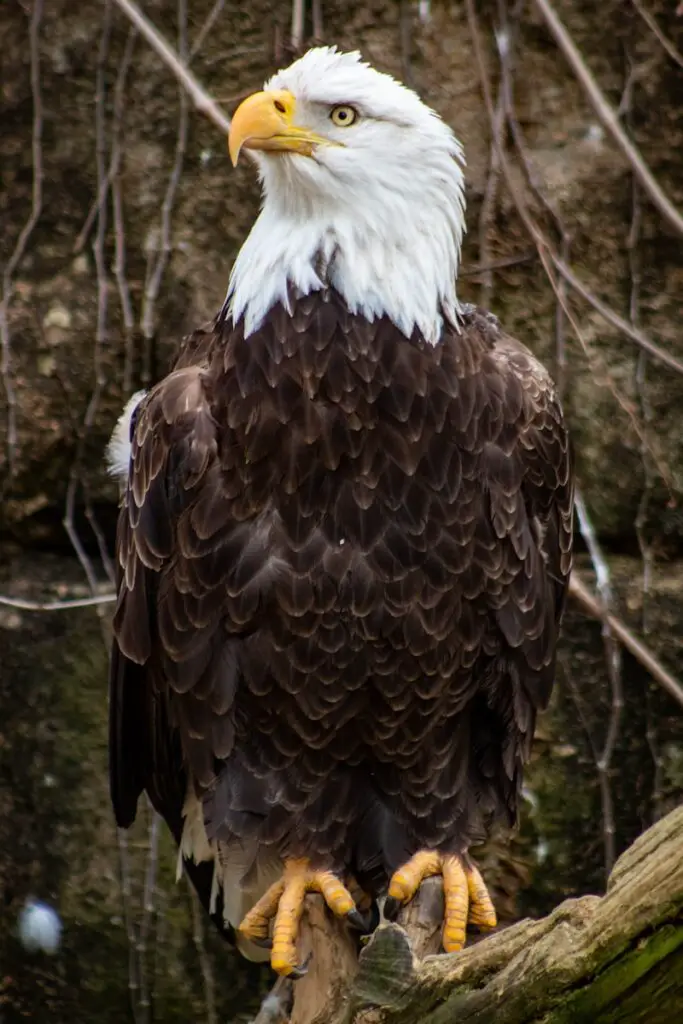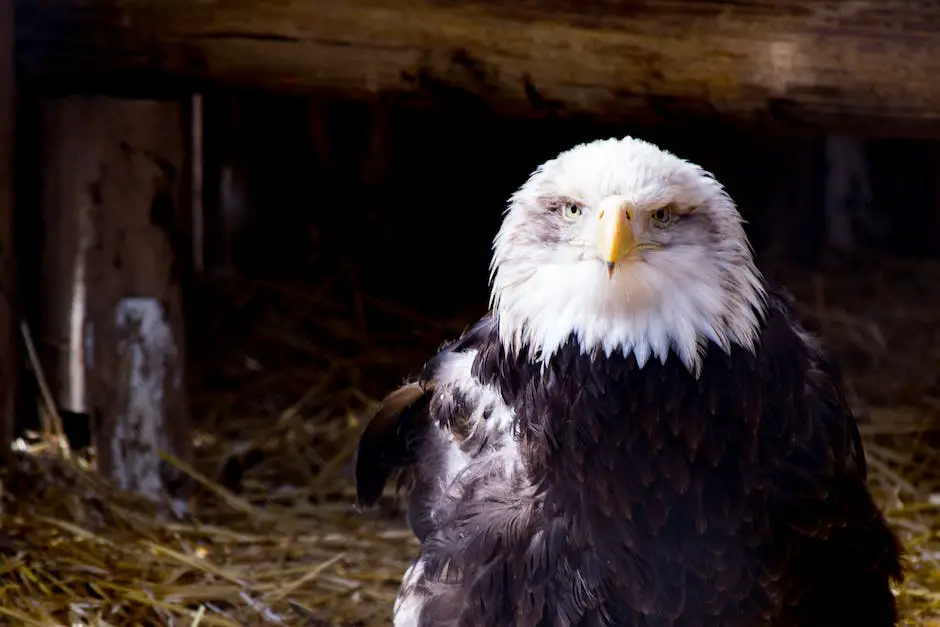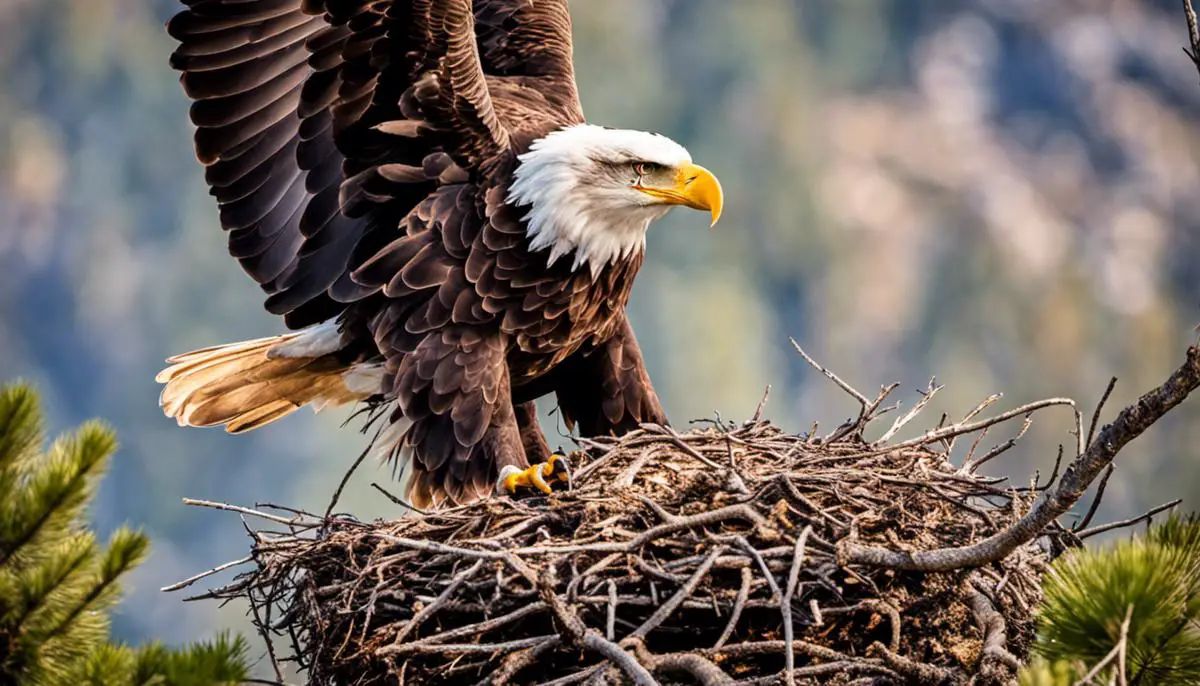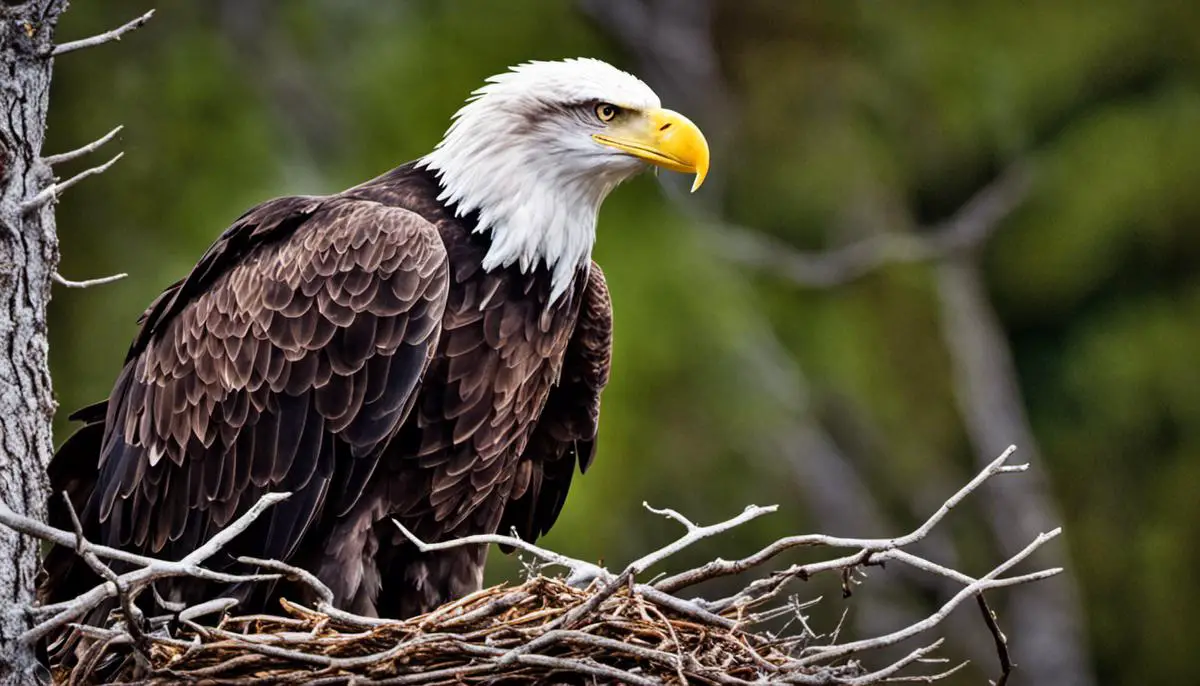Exploring the Magnitude: Size Aspects of Bald Eagle Nests
The majestic Bald Eagle, recognised as a symbol of strength and freedom, is globally admired not only for its striking appearance but also for its unique nesting habits. Particularly intriguing is the aspect of their incredible nest size, a subject that rouses considerable interest in ornithologists.
Bald eagle nests are among the largest of all avian species, prompting an exploration of the formation process, influences on dimensions, and the impact it has on their lifecycle. This discourse also extends to an examination of the changes in these sizes over generations, an ecological perspective that could give invaluable insights into the species’ adaptive behaviour.
Furthermore, we delve into the intersection of conservation efforts and regulations with nest dimensions, shedding light on the intricate ways in which species and the ecosystem interact.

Formation Process and Influences on the Bald Eagle Nest Size
Factors Influencing Bald Eagle Nest Size
Bald eagle nest sizes can significantly vary. However, there are certain factors influencing the formation and size of these nests. Firstly, the age and experience of the eagles play substantial roles. The older and more experienced bald eagles tend to build larger nests, primarily due to an accumulation of added material year after year.
Additionally, the nest’s location can highly impact its overall dimensions. Those built in trees, especially in large, towering ones, on cliffs, or on human-made platforms, are often larger due to the added support these platforms provide. Furthermore, the availability of building materials within the bird’s territory can also dictate the size. A greater abundance of branches, twigs, and other materials can lead to larger nests.
Lastly, the environmental conditions are considered significant. Challenging climates with stronger winds or storms may prompt eagles to build more robust and bigger nests to ensure their durability and survival.
Bald Eagle Nest Site Selection and Construction
When it comes to nest site selection, bald eagles typically choose locations that offer an expansive view of the area, generally atop towering trees or cliffs. They also need proximity to a body of water supporting a steady food supply. The site should have minimal human activity to reduce disturbances and provide safety for the upcoming offspring.
Nest construction involves a systematic procedure. The bald eagles usually start by creating a sturdy platform of large sticks, followed by a soft lining of moss, grass, and feathers. The process takes both the male and female around 1-3 months and follows an intricate layering system including a rim, a lining, and then a bowl-shaped design that holds the eagle and her eggs securely. The size of a newly built nest generally ranges from 1-1.5 meters in diameter and 60 cm to 1.2 meters in depth.
Continuous Nesting Process Contributing to Size
The impressive size of the bald eagle nests is generally a result of repeated nesting in the same spot. The birds refurbish and add to the structure annually, leading to an accumulation that increases both the weight and height of the nest over time. The largest recorded bald eagle’s nest, found in Florida, measured 2.9 meters wide, 6.1 meters deep, and weighed almost three tonnes, which had been continually inhabited for multiple seasons.
However, it’s important to note that bald eagles only form such enormous nests if their location and surroundings remain undisturbed over time. Any form of significant disturbance could lead to the eagles abandoning the nest, halting its growth.
Concluding Remarks: Environmental Impact on Nest Size
Indubitably, the size of a bald eagle’s nest is a complex interplay of numerous elements—biological, geographical, and environmental. It showcases the bird’s exceptional adaptability and ingenuity. Furthermore, the selection of the nesting site and its size offer pivotal insights into the environmental health of the region, given that bald eagles often serve as apex predators, reflecting the overall ecological well-being. Nevertheless, human interventions, habitat demolition, and climate change could greatly influence these impressive structures, potentially altering their typical size in the years to come.

Comparative Analysis of Bald Eagle Nest Sizes
Comprehending Bald Eagle Nest Sizes: Variances across Locations
Bald eagles, scientifically referred to as Haliaeetus leucocephalus, are famous for building some of the largest bird nests, more formally known as ‘aeries’. Typically, these aeries are situated in tall trees adjacent to rivers, lakes, marshes, or coasts. However, the dimensions of these nests can vary greatly based on location, with factors such as geography, local weather conditions, available resources, and individual bird behaviours having a considerable impact.
Average Dimensions of Bald Eagle Nests
On average, a bald eagle nest is 1.5 meters in width and 1 meter in depth. However, as eagle pairs frequently return to the same nest during the breeding season, these structures can grow significantly larger over time through continuous additions of branches and other materials. Consequently, older nests have been found to have much larger dimensions, averaging 2-2.5 meters in width and 1.2-1.8 meters in depth.
Larger Nests: Instances of Exceptional Sizes
There have been several cases of bald eagle nests demonstrating extreme sizes. The Guinness World Records acknowledge the largest bald eagle nest discovered in St. Petersburg, Florida, USA, as measuring a staggering 2.9 meters in width and 6.1 meters in depth, reflecting years of accumulated growth. Other extreme cases include nests reaching the massive weight of two tons.
Size Variations across Geographical Locations
Geographical location plays a significant role in determining bald eagle nest sizes. In regions abundant with large, mature trees such as the forests of Alaska and Canada, bald eagle nests tend to be larger in size due to the availability of ample nesting resources and space. Conversely, in coastal areas or regions with less mature vegetation, like Florida, nests are generally smaller.
Impact of Environmental Factors on Nest Size
Climate is another influential factor. In colder areas, bigger nests made up of densely packed materials help to retain heat, ensuring the survival of the offspring in extreme conditions. In contrast, in relatively warmer climates, the nests are usually smaller and more open to allow air circulation.
Additionally, the abundance or scarcity of food resources can also impact the nest size. In regions with plentiful prey, the necessity to defend a sizeable territory is reduced, allowing eagle pairs to devote more time and energy to building and maintaining larger nests.
Regardless of observed general tendencies, individual habits and preferences of eagles may result in variability, with it not being uncommon to discover a particularly small or large nest in a place less expected. Each nest serves as a testament to the adaptative prowess and tenacity of these noble creatures.

Impact of Nest Size on Bald Eagle’s Life Cycle
Bald Eagle Nest Size and Its Contribution to the Life Cycle
Bald eagles, in their wonder, build incredibly large homes, commonly known as nests or ‘aeries’. From an impressive 1.5 to 3 metres in width, many of these nests can reach up to 4 metres in depth over time. This is due to the eagles’ propensity to return to the same nest year after year, constantly renovating, refurbishing, and increasing the size with each use. The decision regarding nest size bears considerable significance, affecting multiple elements of the bald eagle’s life cycle.
Accommodation of Hatchlings
The size of an eagle’s nest plays a significant role in determining the number of hatchlings it can accommodate. Generally, the average clutch size for bald eagles is around one to three hatchlings. The large size of their nests means that there is ample space for the young eagles to grow and develop before they reach their fledging stage, which typically occurs at around 10–12 weeks of age.
Protection from Predators
Moreover, the nest size is instrumental in offering protection from possible predators. Large nests located high in trees or cliff faces can deter many potential threats, providing the eagles with a vantage point to spot any approaching danger. The added depth from year-to-year renovations also means there is an extra layer of insulation against adverse weather conditions, thereby providing a safe environment for the eggs and the hatchlings.
Influence on Breeding Habits
Nest size significantly influences the breeding habits of bald eagles as well. These impressive constructions require considerable efforts from both the male and female, hence initiating the bonding process and reinforcing the pair bond critical for successful reproduction. Furthermore, the female lays her eggs at 3 to 4-day intervals, allowing each hatchling a preferred status depending on their birth order, which the ample nest space facilitates. This staggered hatching process and the subsequent size difference in nestlings can impact survival odds in dire food situations, equipping one to always be at an advantage.
Nest Size in Relation to Food Availability
The nest size may reflect regional differences in food availability. In regions with plenty of fish, a primary food source for bald eagles, nests tend to be larger as opposed to regions where food is scarce. This could suggest that eagles, where food is abundant, invest more energy in the nest-building process, thanks to the improved nutrition available to them.
In essence, the size of a bald eagle’s nest is directly influenced by various factors related to their lifecycle. This includes the capacity to accommodate their hatchlings, the need to ward off potential threats from predators, their reproduction habits, and variations in food availability specific to the region they inhabit.

Changes in Nest Sizes Over Generations
Understanding Bald Eagle Nest Size from an Evolutionary Perspective
Renowned for their impressively large nests, the Bald Eagle stands out in this regard. As a result of adapting to their respective habitats over several generations, these remarkable birds construct nests that span from 1.5 to 3 metres across and delve 3 to 6 metres in depth. These measurements, looking through an evolutionary lens, appear to be in response to the need for creating robust structures, that not only protect their young from predators but also withstand severe weather conditions.
Generational Construction: A Community Investment
Bald eagles are unique in their nesting habits. Not only do they utilise the same nests for multiple breeding seasons, but they also add material each year, meaning nests can grow significantly over time. This pattern of continued nest expansion can be viewed as a generational investment. The larger the nest, the more protection it offers to the young, boosting their survival chances and hence, the continuity of the eagle line.
Nest Size as an Indicator of Wealth
Theorists have also suggested that nest size might be an indicator of wealth or resource availability. Bald Eagles tend to breed in areas with abundant food supplies. Hence, the ability to construct significant nest structures may be a sign of good feeding grounds, indirectly influencing mate selection.
Impact of Human Activities on Nest Size
Human activities through the years have put Bald Eagles under threat, leading to changes in their nesting behaviour. Overfishing can lead to a reduction in the eagles’ primary food source, affecting their capacity to build larger nests. Urban development also influences nest construction. Encroached territories may force eagles to build smaller, camouflaged nests for protective reasons.
Bald Eagles: Evolutionary Resilience
Throughout several centuries of environmental change, the Bald Eagle’s nest size remains an impressive feat of construction. This has led some researchers to speculate that the ability to maintain and improve nest building is indicative of a species’ resilience.
Building Materials and Nest Size
Predominantly, Bald Eagles use sticks to construct the nest’s base while grass, moss, and other soft materials are used to line the inside. Construction can take about five to six weeks and requires diligent work from both parents. The use of locally found materials for nest construction further substantiates the theory of nest size being influenced by resource availability.
Observations and Further Research
While the observation of the prominent nests created by Bald Eagles provides us with captivating theories, more data is essential to definitively understanding the evolutionary factors that affect the size of their nests. There exists a need for innovative avenues of research to bolster our understanding, which includes the conduction of DNA examinations, longitudinal reviews of individual nest sites, and in-depth geographical studies. Such approaches will greatly enhance our comprehension of the relationship between the biological attributes of these birds, their environmental encounters, and the nests they build.

Conservation Efforts and Regulations Targeting Nest Sizes
Conservation Rules and the Impact on Bald Eagle’s Nest Size
Focusing on a larger perspective with regard to conservation sheds light on a creature revered worldwide for its strength and majesty: the bald eagle. The immense size of their nests is not unsurprising; hence, it is often in the spotlight within ecological discussions, with governments being guided by the implications of regulatory and conservational endeavors. Reports suggest that these eagles have some of the largest nests compared to other bird species, with some exceeding dimensions of 2.5 metres across and 4 metres deep. Nevertheless, it’s critical to note that these figures can fluctuate vastly, depending on site-specific factors and the behaviours of individual birds.
The Impact of Conservation Initiatives
Conservation initiatives have played an instrumental role in the preservation and rehabilitation of the bald eagle. In the United States, the Bald and Golden Eagle Protection Act, established in 1940, expanded to include protection for bald eagle nesting sites in 1962. Furthermore, the Endangered Species Act of 1973 provided additional safeguards. These regulations specified that bald eagle habitats were not to be intruded upon, disturbed, damaged, or destroyed.
These initiatives ensure nesting sites remain undisturbed, but interestingly, they might indirectly affect the nest size. The size of the nest reportedly depends on a range of factors, including the age of the eagle, overall health, and possibly the security of the nesting site. Eagles that experience minimal disturbances have the freedom to construct and expand their nest, resulting in larger nest sizes.
Correlation Between Nest Size and Population
Non-disturbance regulations have contributed to a positive correlation between nest size and bald eagle population numbers. Uninterrupted nest construction is critical for the survival and propagation of these species. Larger nests invariably provide a safe, spacious environment for fledgling eagles to hatch and mature. This propensity for larger nest sizes in secure, non-disturbed areas indirectly supports the potential for an increased eagle population.
The Role of Environmental Education
Coinciding with the regulations, environmental education, and public awareness initiatives have been influential. They ensure the broader public appreciates the sanctity of these sites and refrains from activities that potentially interfere with bald eagle nesting. While larger nests are advantageous for bald eagles, they can also run the risk of attracting careless or curiously destructive human behaviour. Wider recognition of bald eagle preservation integrates the public into larger ecological conservation efforts and helps to safeguard the majestic bird’s habitat—and, by extension, the sizes of their nests.

Masterfully weaning through details pertaining to Bald Eagle nest sizes, including formation, influence, and comparison across different locations, we observe the profound connection between the size of nests and the life cycle patterns of these awe-inspiring birds.
The intriguing shift in nest sizes over generations, perhaps an evolutionary adaptation, speaks to the intimate relationship between the bird and its evolving natural habitat. The exploration is deepened as the nuanced link between conservation strategies, existing laws, and the nest dimensions is navigated, leading us to a better understanding of the need to respect and protect these remarkable manifestations of this species’ behaviour.
As we continue to uncover and understand these complex nesting dynamics, it reinforces the awe and respect these birds draw and further highlights the necessity for meaningful conservation efforts.
